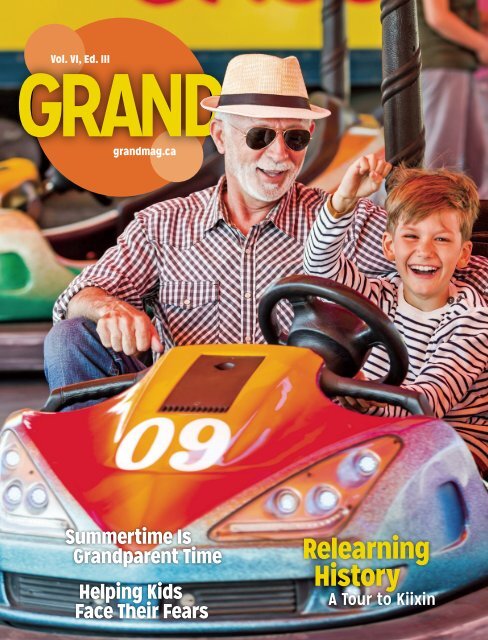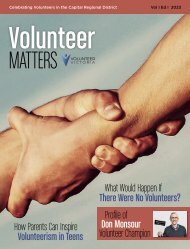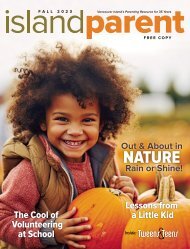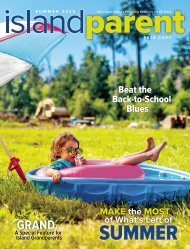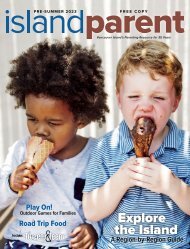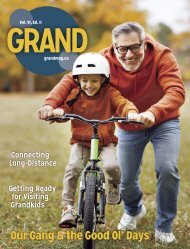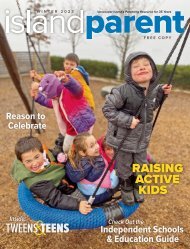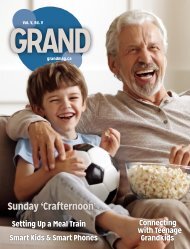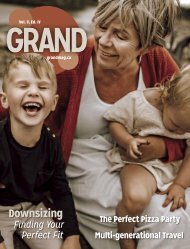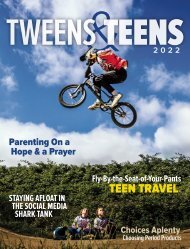GRAND Vol VI, Ed III
GRAND honours and supports grandparents by providing information on resources and businesses for families and a forum for the exchange of ideas and opinions: Relearning History: A Tour to Kiixin • Summertime Is Grandparent Time • Helping Kids Face Their Fears
GRAND honours and supports grandparents by providing information on resources and businesses for families and a forum for the exchange of ideas and opinions: Relearning History: A Tour to Kiixin • Summertime Is Grandparent Time • Helping Kids Face Their Fears
Create successful ePaper yourself
Turn your PDF publications into a flip-book with our unique Google optimized e-Paper software.
<strong>Vol</strong>. <strong>VI</strong>, <strong>Ed</strong>. <strong>III</strong><br />
<strong>GRAND</strong><br />
grandmag.ca<br />
Summertime Is<br />
Grandparent Time<br />
Helping Kids<br />
Face Their Fears<br />
Relearning<br />
History<br />
A Tour to Kiixin
Explore<br />
Relearning History<br />
A Tour to Kiixin<br />
The sky is overcast but the rain is<br />
holding off as we gather at the Kiixin<br />
Tour Office on the East Government<br />
Dock in Bamfield. There are 10 of my<br />
family members present, spanning three<br />
generations, all eager to follow a Traditional<br />
Knowledge Holder through lush<br />
rainforest to an ancient village site on<br />
the west coast of Vancouver Island. Stella<br />
Peters introduces herself as our guide for<br />
the morning, and it’s clear at once that<br />
we’re in good hands. There’s a final washroom<br />
run once we’ve signed our paperwork,<br />
and then we pile into our cars and<br />
following Stella’s truck a short distance<br />
back down the Bamfield Highway and<br />
onto a private gravel road.<br />
With two giant carved figures to welcome<br />
us, the trailhead is impossible to<br />
miss. The figures are Nutchkoa and Hominiki,<br />
we later learn, the first ancestors<br />
of the Huu-ay-aht, one of the Nuu-chahnulth<br />
peoples. As impressive as they are,<br />
the two figures are significantly smaller<br />
than the original carvings first erected in<br />
the village of Kiixin over 160 years ago.<br />
Taken from Kiixin in 1911, the original<br />
figures now stand watch in the lobby<br />
of the Royal BC Museum. New, full-size<br />
figures were carved and installed at the<br />
entrance to the House of Huu-ay-aht at<br />
Pachena Bay in 2000.<br />
As we join the other tour participants<br />
in the shelter at the trailhead, Stella<br />
shares this and more. “Journey with our<br />
ancestors” is one of the taglines of the<br />
tour—and with Stella’s guidance that is<br />
exactly what we do. Her words and visual<br />
materials take us from the distant past to<br />
the present. We learn about the ancient<br />
site itself, a 19th century village and fortress<br />
that shows evidence of continuous<br />
occupation for at least 3,000 years—and<br />
as much as 5,000 years, according to oral<br />
tradition. We learn about the archeological<br />
surveys that Stella participated in—<br />
and her Nation’s decision not to proceed<br />
with a full-scale excavation. We learn<br />
about the traditional skills and practices<br />
that allowed the Huu-ay-aht to live in<br />
this area for millennia. Best of all, we<br />
receive this information from a Traditional<br />
Knowledge Holder rather than an<br />
“outside,” non-indigenous source.<br />
As we move through time, Stella’s<br />
words inevitably lead to more painful<br />
territory—the decimation of the Huu-ayaht<br />
population as the result of European<br />
diseases, the loss of cultural treasures to<br />
19th and 20th century collectors, and the<br />
tragic consequences of the residential<br />
school system. These are difficult but<br />
necessary subjects, and Stella discusses<br />
them in a manner that is both matterof-fact<br />
and sensitive to the presence of<br />
children on the tour.<br />
With our guide’s introduction complete,<br />
we start down the rainforest trail<br />
towards the village site. The trail is not<br />
particularly long (at least not for our<br />
family of hikers), but we take our time,<br />
moving carefully down flights of stairs<br />
and over long sections of boardwalk.<br />
There are frequent stops as well, as<br />
Stella points out things of interest. I’m<br />
fascinated by the culturally modified<br />
trees—ancient cedars with strips of bark<br />
removed for clothing and basket-making,<br />
and other trees with entire planks missing<br />
for cradles, boxes and houses.<br />
Finally, we reach our destination. I’ve<br />
had the privilege of visiting many west<br />
coast beaches and coves, but this one is<br />
particularly breathtaking. It’s a strategic<br />
grandmag.ca
BRIGHT BEGINNING<br />
location as well as a picturesque one, set<br />
for defensive reasons “between the rugged<br />
outer coast and the protected inner<br />
waters of Barkley Sound.” Today there’s<br />
a bear waiting to greet us as we reach the<br />
sand. We keep a respectful distance, and<br />
the bear eventually wanders off—into<br />
the very section of the forest where Stella<br />
was planning to lead us. While we wait<br />
for the bear to wander a little further, we<br />
take out our packed lunches and have a<br />
quick picnic.<br />
Kiixin was the traditional capital village<br />
of the Huu-ay-aht, and it remains a<br />
sacred site. According to Parks Canada,<br />
“it is the only known First Nations village<br />
of more than 100 villages on the southern<br />
B.C. coast that still features significant,<br />
standing traditional architecture.”<br />
To see the remains of these structures<br />
in person, and to hear dramatic stories<br />
from a descendant of the resourceful and<br />
courageous people who lived on the site<br />
for millennia, is an unforgettable experience.<br />
As a child growing up in Nanaimo, I<br />
had very little knowledge of the complex<br />
indigenous cultures that existed on Vancouver<br />
Island before the first newcomers<br />
disembarked from their ships. The curriculum<br />
didn’t cover much local history<br />
back then, and what I did learn mostly<br />
began with the arrival of European explorers<br />
in the 1700’s.<br />
Things are different for my grandchildren—and<br />
for that I am profoundly<br />
grateful. I am especially grateful to Stella<br />
Peters and other Traditional Knowledge<br />
Holders across the Island who are sharing<br />
their stories and cultural teachings<br />
so generously. We can’t change the past,<br />
but we can certainly be intentional about<br />
how we go forward—and learning what<br />
we didn’t know before is an essential part<br />
of that process.<br />
Kiixin Tours are offered from the May<br />
long weekend to Labour Day. While the<br />
4-hour morning tour worked best for<br />
our extended family, there is also an<br />
evening tour, which includes songs and<br />
drumming on the beach. Headlamps or<br />
flashlights and a towel or blanket to sit<br />
on are required on the evening tour. The<br />
hike into Kiixin is rated “moderate plus,”<br />
thanks to uneven terrain, potentially<br />
slippery boardwalks and a steep flight<br />
of stairs down to the beach. According<br />
to the tour website, people with injuries,<br />
mobility challenges or hiking-restricted<br />
medical conditions cannot be accommodated.<br />
Children aged seven and older are welcome<br />
on the tour, as long as they are accompanied<br />
by a parent or guardian aged<br />
19 years or older. For more information,<br />
visit kiixin.ca/tour.<br />
Rachel Dunstan Muller is a<br />
children’s author, storyteller,<br />
podcaster and grandmother.<br />
You can find her podcasts<br />
Hintertales: Stories from the<br />
Margins of History and Sticks<br />
and Stones and Stories<br />
through her website at<br />
racheldunstanmuller.com.<br />
FULL YEAR JUNIOR KINDERGARTEN<br />
1080 Lucas Avenue<br />
Victoria, BC<br />
Full year with option to add<br />
after school care<br />
Lunches provided September - June<br />
Give the gift of a lifetime!<br />
Your granddaughter deserves<br />
the very best experience<br />
to start her academic journey.<br />
Book a school visit<br />
or connect with Enrolment<br />
TODAY!<br />
250-479-7171<br />
enrolment@stmarg.ca<br />
grandmag.ca<br />
<strong>Vol</strong>. <strong>VI</strong>, <strong>Ed</strong>. <strong>III</strong> 3
Grandparenting<br />
Helping Kids Face Their Fears<br />
Every child passes through that<br />
stage of being afraid of monsters—under<br />
the bed, in dark<br />
corners, down in the basement—it<br />
seems to be a universal childhood fear.<br />
This fear can take root before a child<br />
is at an age when a parent can even<br />
reason with them and provide logical<br />
explanations, and even then, that<br />
assurance rarely seems to allay such<br />
deep-seated phobias. And some children’s<br />
fairy tales only serve to fan the<br />
fire—the witch in Hansel and Gretel<br />
who cooks children, the giant in Jack<br />
and Beanstalk who will “grind Jack’s<br />
bones to make his bread” or the big,<br />
bad wolf in The Three Little Pigs who is<br />
out to devour some piggies.<br />
I’ve had these experiences with<br />
my own sons, and now predictably,<br />
my young grandson seems to be going<br />
through the same phase. This was<br />
made clear to me on a recent trip to<br />
the public library. Whenever we visit<br />
the library, I turn my grandson lose in<br />
the children’s section where he will<br />
often tuck himself away with a book<br />
that catches his interest. On this particular<br />
visit, I didn’t notice he had his<br />
nose in a book about monsters until<br />
he asked me to put it back because it<br />
was scaring him. As we walked home<br />
afterwards, I noticed he wouldn’t hold<br />
my hand. Any time I extended my<br />
hand to him, he shied away from me to<br />
the other side of the sidewalk. When I<br />
asked him what was wrong, he said he<br />
didn’t want to hold my hand because<br />
he was afraid I was going to turn into<br />
a monster. So I asked him: “You’ve<br />
known me seven years now, have I ever<br />
turned into a monster?” His answer? “I<br />
don’t think so, but sometimes you look<br />
pretty scary.”<br />
Well…I asked.<br />
How best to handle this touchy subject<br />
of childhood fears and phobias?<br />
In my own childhood, the prevailing<br />
approach by many parents at that time<br />
was a no-nonsense one—there are no<br />
such thing as monsters. Period. Simple<br />
as that. It was as if a child’s fears were<br />
not be “indulged.” I was raised with<br />
this approach and can attest that it did<br />
nothing other than cause me to feel<br />
ashamed and somehow inadequate. Although<br />
on one level, I trusted the word<br />
of my parents (that they wouldn’t lie<br />
to me), but their logic simply could not<br />
quell my fears. I still took the basement<br />
steps two at a time and insisted<br />
on my bedroom door being left open<br />
with the hall light on. My fear of the<br />
dark was so innate and so irrational<br />
that it overruled all common sense until<br />
I was well into my teens.<br />
As a result, my approach with my<br />
own children was very different. Having<br />
been a victim of my own fears, I<br />
didn’t want to make my children feel<br />
bad about experiencing their own. So<br />
I listened, hugged and validated their<br />
concerns. I actually found it helpful<br />
to confess my own childhood fears<br />
to them as a way of illustrating that<br />
at some point, these anxieties which<br />
seem so overwhelming when we’re<br />
young, gradually lessen or fall away<br />
as we grow into adulthood. And yet, I<br />
also readily admitted to them that even<br />
in adulthood, I still have some fears I<br />
continue to grapple with.<br />
4 <strong>GRAND</strong> grandmag.ca
I am pleased to see books in the<br />
public library that address the topic<br />
of childhood fears. I’ve read several<br />
stories with my young grandson that<br />
illustrate the mastering of a particular<br />
phobia. While reading these stories, I<br />
am quick to point out the accompanying<br />
feeling of accomplishment and<br />
pride the child experiences by the<br />
end of the book. Many of these books<br />
employ a well-trusted behavioural<br />
therapy technique in which children<br />
are gradually exposed to their fears<br />
in a safe, secure environment. Take<br />
the fear of spiders, for instance, yet<br />
another phobia of mine! Reading<br />
books together about spiders and their<br />
importance in our ecosystem might<br />
be a way to start addressing this fear.<br />
Having a child look at illustrations and<br />
photos, even gently encouraging them<br />
to touch those photos, can help to desensitize<br />
their fear.<br />
Pointing out spiders in one’s outdoor<br />
environment and watching them<br />
build a web or collecting a spider in a<br />
bug box are some further ideas to help<br />
with desensitising. I am a firm believer<br />
that steps like this help make fears<br />
more manageable. Those fears may<br />
never be calmed, but at least we can<br />
develop coping skills that can serve us<br />
well later on in life.<br />
Susan Gnucci is a local<br />
author and a proud “nonna”<br />
to two young grandsons. She<br />
enjoys sharing her experiences<br />
as a grandparent.<br />
<strong>VI</strong>TALY:<br />
AN EVENING OF WONDERS<br />
Mind-boggling illusions! Brace yourself for the<br />
unexpected!<br />
“One of the most unique and innovative illusionists<br />
in the world”- Chicago Tribune<br />
www.eveningofwonders.com<br />
SATURDAY<br />
DEC 9<br />
7:00 PM<br />
SUITABLE FOR<br />
AGES 8 AND UP<br />
250-721-8480 | tickets.uvic.ca | @UVicFarquhar<br />
92% of mentored youth feel<br />
more confident in themselves<br />
FREE PROGRAM FOR KIDS IN CARE<br />
Big Steps to Success is a mentoring<br />
program for youth living in government<br />
care or with a kinship agreement. Scan to<br />
learn more about why mentoring matters!<br />
grandmag.ca<br />
<strong>Vol</strong>. <strong>VI</strong>, <strong>Ed</strong>. <strong>III</strong> 5
Grandparenting<br />
Summertime Is Grandparent Time<br />
Summertime often means more<br />
time for grandparents to spend<br />
with grandchildren. Sometimes<br />
that’s a vacation or cottage getaway.<br />
Sometimes it’s a childcare-in-the-city<br />
situation. Either way, it may be a time<br />
where grandparents get more day-to-day<br />
interaction with their grandkids who are<br />
not in school. With lots of activities and<br />
destinations to choose from, how does a<br />
grandparent decide what to do?<br />
You may want to think about activities,<br />
which, while being fun and novel, will<br />
also support academic learning. Some<br />
of these will be obvious, but some might<br />
have benefits you have not thought of.<br />
Take the dolls tea party, for example.<br />
Set the table for tea time with the dolls,<br />
stuffed animals and action figures—don’t<br />
forget about the beloved cars and trucks.<br />
Discuss patterns, distributing one napkin<br />
to each creature, anticipating the needs<br />
of others. Pouring out the “tea” and passing<br />
the cookies provides practice in turntaking<br />
and polite pleases and thank yous.<br />
If you want to go all out, how about<br />
baking the cookies? Choose a really simple<br />
recipe with few ingredients. But even<br />
a three-year-old can help to measure and<br />
pour and stir. Cooking is a great way to<br />
reinforce math concepts (measurements<br />
of volume and weights, setting timers,<br />
talking about temperatures).<br />
Baking is also an opportunity for practicing<br />
fine motor skills, pouring, cutting<br />
(butter, with a table knife, for example—<br />
nothing sharp!), blending butter into<br />
flour. It gives kids a chance to experience<br />
and talk about textures (powdery flour,<br />
greasy butter) which they don’t feel<br />
every day, as well as smells: cinnamon,<br />
lemon peel, cloves. Not to mention the<br />
way soft dough become crisp cookie—it’s<br />
not magic, it’s chemistry!<br />
Building with blocks provides lots<br />
of opportunities to practice fine motor<br />
coordination and engineering skills. Of<br />
course it all starts with you building a<br />
tower and your grandchild knocking it<br />
down. A great exercise in turn taking!<br />
A little later, set up a small construction<br />
and challenge your grandchild to copy<br />
it. Then ask them to set you a challenge.<br />
Create enclosures for toys animals and<br />
dinosaurs. Make a house for the dolls.<br />
Lots of opportunities for telling stories.<br />
With older kids (4 and up) grandparents<br />
can teach them card games. Start<br />
with sorting the cards into red and black,<br />
or suits, or numbers versus face cards.<br />
Progress to Memory where all the cards<br />
are laid out face down and each player<br />
turns over two at a time. The goal is to<br />
remember where the cards are and find<br />
matching pairs. Games like War and<br />
PishePasha great starting games that<br />
don’t require small kiddy-hands to hold<br />
fanned-out cards (that’s a difficult fine<br />
motor skill!). By the time kids are 6 or<br />
7, they can learn Crazy Eights or Gin<br />
Rummy. And I know eight-year-olds who<br />
play Bridge!<br />
Outdoor play is a great time to develop<br />
gross motor skills, like running, kicking<br />
and throwing.<br />
These skills take a long time to develop<br />
and kids need a lot of practice! Take the<br />
opportunity to discuss things we CAN<br />
kick and throw (balls in the field, stones<br />
into the water) and those we must not.<br />
There are lots of games you can create<br />
around throwing stones into the ocean<br />
or a lake: who can throw it farther (of<br />
course), who can hit that log, who can<br />
do the silliest throw, who can throw over<br />
their shoulder. But just meditatively tossing<br />
stones in the water can make space<br />
for conversation and connection.<br />
Time outdoors also promotes healthy<br />
eye development. Studies have shown<br />
that spending a couple of hours a day<br />
outdoors reduces the incidence of myopia<br />
(short-sightedness). It seems that the<br />
bright light of the outdoors, and the opportunity<br />
to focus on the far-away things<br />
give the eyes the stimulation they need.<br />
On Vancouver Island we are so lucky<br />
to have relatively easy access to the shore<br />
and the ocean.<br />
There are so many opportunities there<br />
for wildlife observation, exploring tide<br />
pools, building sand castles, collecting<br />
pebbles or driftwood. But remember that<br />
just being outdoors, with unstructured<br />
time is hugely beneficial for children—<br />
and everyone else. The fresh air, the sunshine<br />
(remember sunscreen, hats, and<br />
the hydrantion), and the freedom is what<br />
summer is all about!<br />
Eva Bild, MA, AdvCD(DONA), LCCE<br />
is a Childbirth and Lactation<br />
<strong>Ed</strong>ucator, and Birth Doula<br />
Trainer. She has been teaching<br />
and supporting childbearing<br />
families in Victoria since 1994.<br />
She become a grandmother this year!<br />
6 <strong>GRAND</strong> grandmag.ca
September<br />
2, 3 & 4<br />
2023<br />
Jammin’<br />
at the<br />
Fair!<br />
Celebrate 155 years of the Saanich Fair<br />
September 2, 3 and 4 at the Saanich Fair Grounds!<br />
MIDWAY, 4-H, CONCESSIONS AND MUCH, MUCH MORE!<br />
saanichfair.ca<br />
IslandParent.ca<br />
Summer 2023 7
Gone are the days of rocking chairs and<br />
recliners. Today’s grandparents are more<br />
likely to be rock climbing or going for a run<br />
than they are to be rocking or reclining.<br />
<strong>Vol</strong>. <strong>VI</strong>, <strong>Ed</strong>. <strong>III</strong><br />
RAND<br />
grandmag.ca<br />
We’re an active and diverse group—an engaged,<br />
evolving and powerful force. We’re<br />
mentors, nurturers, keepers of secrets.<br />
We’re caregivers, child care providers,<br />
dessert-before-dinner defenders. We’re<br />
historians, spiritual guides and the holders<br />
of family stories.<br />
<strong>GRAND</strong> celebrates who you are as a grandparent<br />
and who you are as an individual.<br />
You love spending time with your grandchildren<br />
and you’re happy in your other<br />
roles: at work, in the community and on<br />
your own. <strong>GRAND</strong> acknowledges that you<br />
are not “one or the other”—an “either/or”<br />
version of yourself—you are many different<br />
things to many different people. And to<br />
yourself.<br />
Summertime Is<br />
Grandparent Time<br />
Helping Kids<br />
Face Their Fears<br />
Jim Schneider Publisher<br />
publisher@islandparent.ca<br />
Sue Fast <strong>Ed</strong>itor<br />
editor@islandparent.ca<br />
Kristine Wickheim Account Manager<br />
kristine@islandparent.ca<br />
RaeLeigh Buchanan Account Manager<br />
raeleigh@islandparent.ca<br />
<strong>GRAND</strong>, published by Island Parent Group Enterprises Ltd., is a digital<br />
publication that honours and supports grandparents by providing<br />
information on resources and businesses for families and a forum<br />
for the exchange of ideas and opinions. Views expressed are not<br />
necessarily those of the publisher. No material herein may be<br />
reproduced without the permission of the publisher.<br />
518 Caselton Place, Victoria, BC V8Z 7Y5<br />
Relearning<br />
History<br />
A Tour to Kiixin<br />
250-388-6905 grandmag.ca<br />
A proud member of<br />
BC<br />
With an Island perspective that speaks<br />
to an international readership, <strong>GRAND</strong> is<br />
the source for on-the-go grandparents of<br />
up-to-the-minute and thought-provoking<br />
information and ideas—on everything from<br />
having fun, staying fit and things to do to<br />
travel, leisure, health and technology. Think<br />
of <strong>GRAND</strong> as a trusted friend who happily<br />
shares those “senior moments” (in the<br />
best sense of the words!) and keeps you<br />
informed and connected to the issues and<br />
ideas that really matter. After reading an<br />
issue of <strong>GRAND</strong>, you should feel inspired,<br />
up-to-date and informed.<br />
We’re here for you: from helping you<br />
figure out where you fit in to tackling your<br />
most perplexing questions, sharing your<br />
greatest discoveries and celebrating your<br />
deepest joys.<br />
<strong>GRAND</strong> features articles on topics ranging<br />
from the importance of storytelling,<br />
cooking with your grandkids and community<br />
superheroes, to photographing your<br />
grandkids, gift-giving and grandparenting<br />
from afar. There are ideas and inspiration<br />
to help keep you in-the-know and connected,<br />
there’s a guide to investing in your<br />
grandchildren’s future and there’s tech<br />
support that will help you face your fears<br />
and embrace the cloud.<br />
<strong>GRAND</strong> is as diverse and engaged as you<br />
are. Together, we’re a powerful and positive<br />
force—in our grandchildren’s lives and<br />
in our communities.<br />
8 <strong>GRAND</strong> grandmag.ca
Did you know<br />
8 out of 10<br />
struggling<br />
readers have<br />
an eye tracking<br />
problem?<br />
Vision Therapy<br />
in Victoria and Nanaimo<br />
If your child’s eyes cannot track properly, they will<br />
not be able to see the words the same way you do.<br />
When the eyes aren’t perfectly aligned, each eye<br />
may end up jumping to a different letter, further<br />
confusing your young reader.<br />
This can lead to symptoms like:<br />
• Skipping lines and losing • Guessing at words<br />
their place<br />
• Poor fluency<br />
• Not recognizing a word they • Missing small words<br />
just learned<br />
Dr. McCrodan and Dr. Irvine have been<br />
working with patients for over 10 years,<br />
and have helped thousands of children<br />
improve their reading and learning.<br />
Dr. McCrodan shares his journey in<br />
neuro-visual optimization through the<br />
eyes of his patients.<br />
Visit our website today to get your copy!<br />
Dr. Cameron<br />
McCrodan<br />
Dr. Scott<br />
Irvine<br />
Dr. McCrodan supports<br />
patients of all ages and<br />
abilities, including<br />
those with reading and<br />
learning issues, head<br />
trauma, concussions,<br />
and sports vision needs.<br />
He is a published<br />
author and has<br />
presented for TEDx on<br />
his discoveries.<br />
Dr. Irvine has dedicated<br />
his career to connecting<br />
with patients and<br />
helping to improve their<br />
quality of life. He<br />
specializes in helping<br />
patients overcome<br />
visual problems related<br />
to concussion, dizziness,<br />
reading and learning.<br />
OPTO-MIZATION<br />
NEURO<strong>VI</strong>SUAL PERFORMANCE<br />
IslandParent.ca<br />
Victoria, BC.<br />
200-775 Topaz Ave.<br />
victoria@opto-mization.com<br />
Ph. 250.590.7384<br />
Nanaimo, BC.<br />
205-1825 Bowen Rd<br />
nanaimo@opto-mization.com<br />
Ph. 250.591.0270<br />
Visit our website and have your child take our complementary vision therapy quiz.<br />
Summer 2023 9


